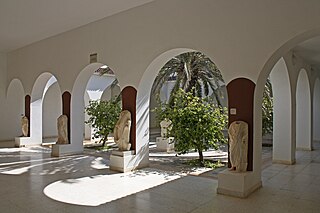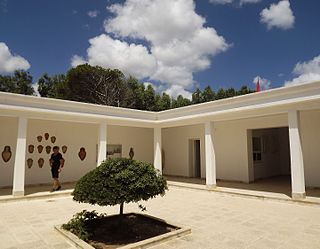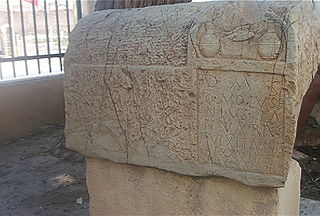
Salakta is a small Tunisian village situated by the sea.

Lemta, historically Leptiminus, is a town in Tunisia with a history going back over 3,000 years.

The Bardo National Museum or Bardo Palace is a museum of Tunis, Tunisia, located in the suburbs of Le Bardo.

El Djem Archaeological Museum is an archaeological museum located in El Djem, Tunisia. It contains Roman era art, including mythological personages, abstract elements and fauna.

Gafsa Archaeological Museum is an archaeological museum in Gafsa, Tunisia. It sits in the old city center. Opposite the museum are ancient Roman pools.

Kerkouane Archaeological Museum is an archaeological museum located in Kerkouane, Tunisia. It contains statuary, jewelry and ceramic art.
The Sfax Archaeological Museum is an archaeological museum located in Sfax, Tunisia.

The Sousse Archaeological Museum is an archaeological museum located in Sousse, Sousse Governorate, Tunisia.

The Carthage Paleo-Christian Museum is an archaeological museum of Paleochristian artifacts, located in Carthage, Tunisia. Built on an excavation site, it lies above the former Carthaginian basilica.

The Bulla Regia Museum is an archaeological museum in Bulla Regia, Tunisia.

The Chemtou Museum is an archaeological museum located in Chemtou, Tunisia. The museum was designed by archaeologists with the Tunisian National Heritage Institute and the German Archaeological Institute with offices located in Rome, Italy. It has the distinction of being located in the area of the old Roman city of Simmithu, near the entrepot's marble quarry in what was the ancient Berber kingdom of Numidia.
Dahmani is a town in the Kef Governorate, located in northwestern Tunisia, with a population of around 31,000 inhabitants. Situated 27 km from El Kef and at an altitude of 625 meters, the town enjoys a cool climate, where snowfall can occur in winter. Dahmani is known for its pure water, making it a fertile region conducive to agriculture.
Ksour Essef or Ksour Essaf is a town and commune in the Mahdia Governorate, Tunisia, on the coast of the Sahel, about 200 km south of Tunis. As of 2014 it had a population of 36,274.

Thyna, formerly Henchir-Tina, is a town and commune in the Sfax Governorate, Tunisia. As of 2004 it had a population of 26,635. It is located on the coast about 12 km (7 mi) south of Sfax.
Sidi El Hani is a town and commune in the Sousse Governorate, Tunisia located at 35.67n, 10.30e. As of 2004 it had a population of 3,058. It gives its name to the largest lake of the governorate, a natural salt lake or salt pan (sabkha) in dry seasons, the Sebkhet de Sidi El Hani which is shared with between one and two other areas depending on precipitation and its maximum extent forms the official boundary with part of a third, Monastir Governorate. The town is 30 km south-west of the coast, its straightest connection being by Tunisian Railways, with a secondary connection by road, the P12 road which is a principal road to Kairouan from the A1 a few kilometres to the east. it is 19 km from Kairouan and 26 km from Raqqada.
The International Council of Museums defines a museum as "a not-for-profit, permanent institution in the service of society that researches, collects, conserves, interprets and exhibits tangible and intangible heritage. Open to the public, accessible and inclusive, museums foster diversity and sustainability. They operate and communicate ethically, professionally and with the participation of communities, offering varied experiences for education, enjoyment, reflection and knowledge sharing.”
The Mahdia Museum is a museum in Tunisia specialising in Tunisian archaeology and heritage. It is located in the city of Mahdia.

Mechouia salad is a Tunisian salad. A very popular first course dish from Tunisia, a country in North Africa that appreciates spiciness, it is especially consumed in the summer, and is a grilled vegetable, tomatoes, peppers, onions and garlic salad, that may also contain eggplant. They are grilled in the oven or on the stove and then ground together, spiced, and then tuna and olive oil are added, and sometimes boiled eggs are placed for decoration.

The Skifa Kahla, also known as Bab Zouila, is a fortification of the 10th century, the structure is one of the few remnants of the ancient walls of Mahdia in Tunisia. The building was built by the Fatimids, in which it was used as the main fort to protect the access to the city. The fort is one of the few remnants of the ancient ramparts, as well as being one of the access points to the historic center of Mahdia.














